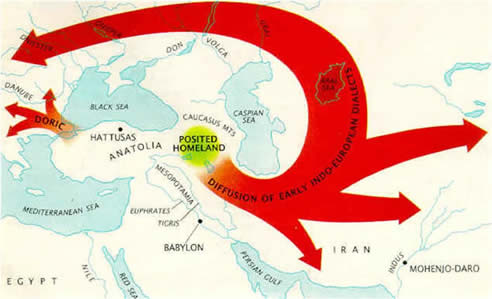India Acquired Language, Not Genes From the West
by Brian Handwerk, National Geographic News, January 10, 2006
Most modern Indians descended from South Asians, not invading Central Asian steppe dwellers, a new genetic study reports.

The Indian subcontinent may have acquired agricultural techniques and languages—but it absorbed few genes—from the west, said Vijendra Kashyap, director of India's National Institute of Biologicals in Noida.
The finding disputes a long-held theory that a large invasion of central Asians, traveling through a northwest Indian corridor, shaped the language, culture, and gene pool of many modern Indians within the past 10,000 years.
That theory is bolstered by the presence of Indo-European languages in India, the archaeological record, and historic sources such as the Rig Veda, an early Indian religious text.
Some previous genetic studies have also supported the concept.
But Kashyap's findings, published in the current issue of the Proceedings of the National Academies of Science, stand at odds with those results.
True Ancestors
Testing a sample of men from 32 tribal and 45 caste groups throughout India, Kashyap's team examined 936 Y chromosomes. (The chromosome determines gender; males carry it, but women do not.)

The data reveal that the large majority of modern Indians descended from South Asian ancestors who lived on the Indian subcontinent before an influx of agricultural techniques from the north and west arrived some 10,000 years ago.
Most geneticists believe that humans first reached India via a coastal migration route perhaps 50,000 years ago.
Soon after leaving Africa, these early humans are believed to have followed the coast through southern India and eventually continued on to populate distant Australia.
Peter Underhill, a research scientist at the Stanford University School of Medicine's department of genetics, says he harbors no doubts that Indo-European speakers did move into India. But he agrees with Kashyap that their genetic contribution appears small.
"It doesn't look like there was a massive flow of genes that came in a few thousand years ago," he said. "Clearly people came in to India and brought their culture, language, and some genes."
"But I think that the genetic impact of those people was minor," he added. "You'd don't really see an equivalent genetic replacement the way that you do with the language replacement."
Language, Genes Tell Different Tales
Kashyap and his colleagues say their findings may explain the prevalence of Indo-European languages, such as Hindi and Bengali, in northern India and their relative absence in the south.
"The fact the Indo-European speakers are predominantly found in northern parts of the subcontinent may be because they were in direct contact with the Indo-European migrants, where they could have a stronger influence on the native populations to adopt their language and other cultural entities," Kashyap said.
He argues that even wholesale language changes can and do occur without genetic mixing of populations.
"It is generally assumed that language is more strongly correlated to genetics, as compared to social status or geography, because humans mostly do not tend to cross language boundaries while choosing marriage partners," Kashyap said.
"Although few of the earlier studies have shown that language is a good predictor of genetic affinity and that Y chromosome is more strongly correlated with linguistic boundaries, it is not always so," he added.
"Language can be acquired [and] has been in cases of 'elite dominance,' where adoption of a language can be forced but strong genetic differences remain [because of] the lack of admixture between the dominant and the weak populations."
If steppe-dwelling Central Asians did lend language and technology, but not many genes, to northern India, the region may have changed far less over the centuries than previously believed.
"I think if you could get into a time machine and visit northern India 10,000 years ago, you'd see people … similar to the people there today," Underhill said. "They wouldn't be similar to people from Bangalore [in the south]."
|  Home
Home Archives
Archives Home
Home Archives
Archives